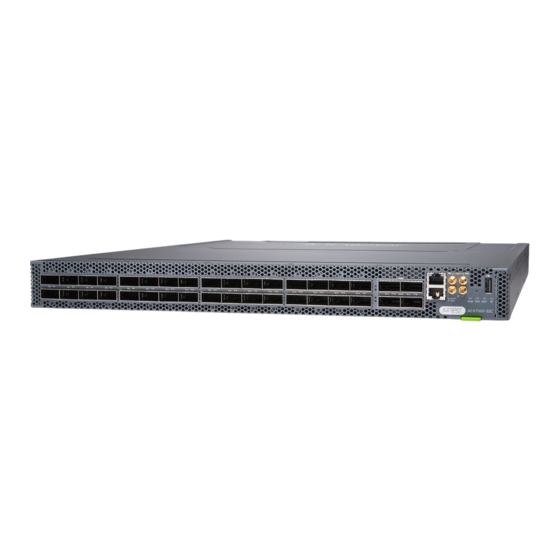Advertisement
Quick Links
Day One+
ACX7100-32C
IN THIS GUIDE
Step 1: Begin | 1
Step 2: Up and Running | 7
Step 3: Keep Going | 11
Step 1: Begin
IN THIS SECTION
Meet the ACX7100-32C | 1
Install the ACX7100-32C | 2
Power On | 4
In this guide, we provide a simple, three-step path, to quickly get you up and running with your new ACX7100-32C. We've
simplified and shortened the installation and configuration steps, and included how-to videos. You'll learn how to install
an AC-powered ACX7100-32C in a rack, power it up, and configure basic settings. If you need instructions for installing
a DC-powered ACX7100-32C, see the
Meet the ACX7100-32C
®
The Juniper Networks
ACX7100-32C is a high-performance router with deep buffer capabilities that address the increasing
requirements of traffic growth and latency-dependent applications. Powered by the Junos
the ACX7100-32C routers offer high port density and MACsec–ready ports, making them ideal for secure and high-end
service aggregation and top-of-rack, spine-and-leaf data center applications.
ACX7100-32C Hardware Guide.
®
OS Evolved operating system,
Advertisement

Subscribe to Our Youtube Channel
Summary of Contents for Juniper Day One+ ACX7100-32C
- Page 1 DC-powered ACX7100-32C, see the ACX7100-32C Hardware Guide. Meet the ACX7100-32C ® The Juniper Networks ACX7100-32C is a high-performance router with deep buffer capabilities that address the increasing ® requirements of traffic growth and latency-dependent applications. Powered by the Junos OS Evolved operating system, the ACX7100-32C routers offer high port density and MACsec–ready ports, making them ideal for secure and high-end...
- Page 2 The ACX7100-32C router is a 1-U, fixed-configuration router that provides a throughput of 4.8 Tbps while maintaining a power-efficient footprint. It has 32 QSFP28 ports that operate at 100-Gbps and four QSFP56-DD ports that operate at 400-Gbps. We ship the ACX7100-32C router with redundant power supplies. You can order it with front-to-back airflow (airflow out or AO), and with AC or DC power supplies.
- Page 3 An electrostatic discharge (ESD) grounding strap A management host such as a laptop or desktop PC A serial-to-USB adapter (if your laptop or desktop PC doesn’t have a serial port) A grounding cable: 14-10 AWG (2-5.3 mm²), stranded wire, or as permitted by the local code, with a Panduit LCD10-10A-L or equivalent lug attached Two #10-32 screws to secure the grounding lug CAUTION:...
- Page 4 6. While you’re holding the router in place, have a second person insert and tighten the rack mount screws to secure the mounting rails to the rack rails. Make sure they tighten the screws in the two bottom holes first, and then tighten the screws in the two top holes.
- Page 5 1. Wrap and fasten one end of the ESD grounding strap around your bare wrist, and connect the other end to one of the ESD grounding points on the router. 2. Use two #10-32 screws to secure the grounding lug and attached cable to the chassis. Attach the lug through the left rail and blade assembly to the chassis.
- Page 6 9. Slide the power cord retainer loop toward the power supply until the loop is snug against the base of the coupler. 10. Press the tab on the loop, and draw out the loop into a tight circle. WARNING: Ensure that the power cord does not block access to router components or drape where people can trip on it.
-
Page 7: Step 2: Up And Running
Step 2: Up and Running IN THIS SECTION Plug and Play | 8 Customize the Basic Configuration | 8 Now that the ACX7100-32C is powered on, let’s do some initial configuration to get it up and running on the network. It’s simple to configure and manage the ACX7100-32C using the CLI. -
Page 8: Plug And Play
Plug and Play The ACX7100-32C router ships with factory-default settings that enable plug-and-play operation. These settings load as soon as you power on the router. Customize the Basic Configuration You can easily customize the factory-default configuration with just a few commands. Initially, you’ll need to make changes through the console port. - Page 9 4. Start the CLI. [vrf:none] root@re0:~# cli 5. Enter configuration mode. root@re0> configure 6. Stop the chassis auto-upgrade process. [edit] root@re0# delete chassis auto-image-upgrade 7. Stop zero-touch provisioning (ZTP). [edit] root@re0# delete system commit factory-settings NOTE: ZTP is enabled on the ACX7100-32C in the factory-default configuration. You must stop ZTP before you configure any settings.
- Page 10 2>/dev/null) 10. (Optional) Give the router a name. If the name includes spaces, enclose the name in quotation marks (“ ”). [edit] root@re0# set system host-name host-name 11. Configure the default gateway. [edit] root@re0# set routing-options static route 0.0.0.0/0 next-hop destination-ip 12.
-
Page 11: What's Next
NOTE: By default, users are not allowed to log in to the router as root through SSH. 17. Commit the configuration. Your changes become the active configuration for the router. [edit] root@re0# commit Step 3: Keep Going IN THIS SECTION What’s Next? | 11 General Information | 12 Learn With Videos | 12... -
Page 12: General Information
Juniper Portal Juniper Networks, the Juniper Networks logo, Juniper, and Junos are registered trademarks of Juniper Networks, Inc. in the United States and other countries. All other trademarks, service marks, registered marks, or registered service marks are the property of their respective owners. Juniper Networks assumes no responsibility for any inaccuracies in this document. Juniper Networks reserves the right to change, modify, transfer, or otherwise revise this publication without notice.














Need help?
Do you have a question about the Day One+ ACX7100-32C and is the answer not in the manual?
Questions and answers